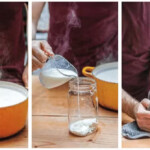Homemade Yogurt with Kefir Starter
This yogurt-making method uses kefir as the starter culture, offering a rich, diverse mix of beneficial microbes that create a thick, flavorful yogurt without commercial packets. Adapted from The Art of Natural Cheesemaking by David Asher, this technique focuses on careful milk handling—cooking it slowly, cooling it properly, and incubating it at the right temperature to achieve the perfect texture. Whether you're using raw or pasteurized milk, kefir brings both convenience and complexity to homemade yogurt.
Servings: 12 servings, makes about 3 quarts
Ingredients
- 1 gallon Whole milk pasteurized or raw, preferably unhomogenized
- 3/4 cup active kefir 180 mL, strained kefir grains, prepared the day before, or yogurt
Instructions
- Slowly warm the milk to 185°F (85°C) over medium heat. Stir the milk as it warms.
- Cook the milk at 185°F for 30 minutes to 1 hour. Stir it nonstop. The longer the milk is cooked, the thicker the yogurt will be.
- Cool the milk to 110°F (43°C): Take the pot of milk off the heat, and stir it until the temperature falls to that point. Don't add the culture before it cools to 110 F or you may kill the culture.
- Add the yogurt culture to the milk: Add 1⁄4 cup (60 mL) of kefir to the warm milk. Stir to incorporate
- Incubate the kefir yogurt for 12 to 36 hours, until it's reached the desired flavor and consistency. Kefir culture is notoriously unpredictable in therms of incubation times for yogurt, so just try to check on it every 12 hours or so until fully cultured.
Notes
Milk Choice: This method works with raw or pasteurized milk, but raw milk will produce a true raw milk yogurt if the kefir is also made with raw milk. For the thickest texture, use whole milk, and avoid ultra-pasteurized milk, which doesn’t culture well.
Kefir Starter: You can use milk kefir grains or kefir made from them as the starter culture. Be sure the kefir is active and recently cultured—older kefir may not ferment the yogurt as effectively.
Texture Tips: Don’t rush the cooking stage. Holding the milk at 185°F for at least 30 minutes helps concentrate it and denature the proteins for a thicker yogurt. Stir constantly while heating and cooling to prevent a skin from forming.
Incubation: Keep the inoculated milk between 100–110°F for best results. A cooler or insulated container works well, or you can use an oven with the light on. Avoid letting the temperature drop too low, as this may favor yeast development rather than the desired bacteria.
Flavor Profile: Yogurt made with kefir tends to have a milder flavor and less tang than traditional yogurt, with a smooth, rich mouthfeel. If you prefer a sharper taste, allow it to ferment a bit longer before chilling.
Nutrition
Serving: 1cup | Calories: 189kcal | Carbohydrates: 15g | Protein: 10g | Fat: 10g | Saturated Fat: 6g | Polyunsaturated Fat: 0.3g | Monounsaturated Fat: 2g | Cholesterol: 38mg | Sodium: 120mg | Potassium: 473mg | Sugar: 15g | Vitamin A: 511IU | Calcium: 388mg
